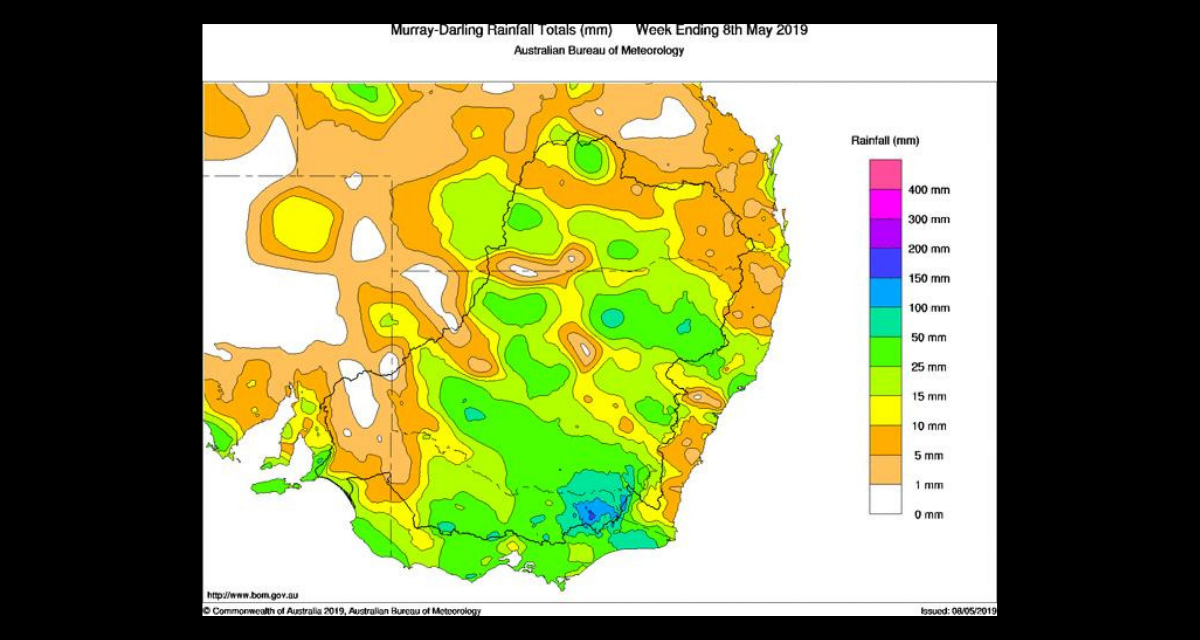Rainfall and inflows
Rainfall was widespread across much of the Murray-Darling Basin last week with the highest falls recorded across the Victorian and Australian Alps.
In Victoria, the highest totals included 173 mm at Rocky Valley, 126 mm at Mongans Bridge and 109 mm at Dartmouth Dam in the northeast. Further west in Victoria, Goulburn Weir recorded 50 mm, Swan Hill AWS recorded 23 mm and Mildura recorded 28 mm.
In southern New South Wales, 128 mm was recorded at Thredbo AWS and 100 mm at Perisher Valley, both just outside the Basin catchment in the Snowy Mountains. On the southwest slopes, Khancoban AWS recorded 85 mm, Tumbarumba 60 mm and Hume dam 57 mm. Further west in NSW, 71 mm was recorded at Culcairn, 54 mm at Morundah and 47 mm at Karpa Kora. In northern NSW, highest totals included 60 mm at Gwabegar and 43 mm at Walgett and Gunnedah airports.
In South Australia, highest totals include 36 mm at Macclesfield and 28 mm at Mount Barker in the Lofty Ranges and 28 mm at Meningie at the Lower Lakes.
In Queensland highest totals included 45 mm at Wallen and 38 mm at Whyenbah in the Warrego catchment.
Rainfall this week went some way to wet up catchments and delivering streamflow rises in the upper Murray tributaries. Flow in the upper Mitta Mitta River at Hinnomunjie reached above 9,000 ML/day before quickly receding. In the upper Murray at Biggara, the flow peaked at around 3,200 ML/day. These are the highest flows recorded at these locations since December 2017. Inflows from the Kiewa River to the Murray, measured at Bandiana, peaked around 3,800 ML/day, whilst the Ovens River at Wangaratta reached 1,850 ML/day. These are the highest flows recorded at these locations since December 2018.
System operations
The past 12 months have seen very low inflows to the River Murray system. Transfers from Dartmouth to Hume Reservoir and from Hume to Lake Victoria were required to ensure all system demands could be met over a very hot and dry summer and autumn period. Along with these transfers, the Lake Victoria storage was drawn on very heavily to help meet system demands. As a result Lake Victoria reached the fifth lowest level recorded in the past 50 years. Deliberately targeting a low storage level maximises the opportunity for any tributary inflows downstream of Hume Dam over autumn and winter to be captured in Lake Victoria – conserving volumes held in upstream storages.
Following recent rainfall, and as the irrigation season draws to a close, system transfers between Dartmouth, Hume and Lake Victoria have been reduced. Transfers from Dartmouth to Hume Reservoir ceased in March and both releases from Hume and IVT delivery from the Goulburn system have significantly reduced. Over the coming week there is a low risk of a shortfall (based on current demands, weather forecasts and operations).
River operations
The MDBA active storage volume increased by 68 GL this week to 2,888 GL (34% capacity).
At Dartmouth Reservoir, the storage volume increased by 17 GL to 2,459 GL (64 per cent capacity). The release from Dartmouth, measured at Colemans, reduced from around 400 ML/day to 280 ML/day. Downstream on the Mitta Mitta River at Tallandoon, the flow briefly peaked around 5,000 ML/day in response to inflows from Snowy Creek following more than 150 mm of rainfall in that catchment.
At Hume Reservoir, the storage volume increased by 37 GL to 442 GL (15 per cent capacity). The release from Hume reduced to the minimum flow target of 600 ML/day as inflows from the Kiewa and Ovens Rivers increased following this week’s rain.
Downstream at Lake Mulwala the level is currently at 124.84 m AHD which is within the normal operating range (124.6 to 124.9 m AHD). Irrigation diversions to Mulwala Canal eased earlier in the week following rainfall in the irrigation areas and ceased for the season on May 8. Murray Irrigation Limited (MIL) will undertake major works during the off-season with refilling of the irrigation network expected to commence on July 24. The diversion to Yarrawonga Main Channel (YMC) is low, at around 150 ML/day with the majority of this flow being returned to the Murray via Broken Creek. Irrigation diversions at YMC are expected to cease on May 15.
The release from Yarrawonga Weir briefly increased to around 6,500 ML/day as inflows from the Kiewa and Ovens Rivers were passed downstream. The release is now reducing as the inflows recede and is currently 5,000 ML/day. If rainfall forecast for the coming days is relatively modest, and conditions remain dry in the coming weeks, the release is expected to reduce to 4,000 ML/day and be maintained around this rate during May on behalf of environmental water holders for the benefit of native fish along the length of the Murray.
The Edward River and Gulpa Creek offtakes are currently passing 1,220 ML/day and 290 ML/day respectively with all gates raised clear of the water. Inflows to the Edward-Wakool system through the Edward and Gulpa offtakes are expected to fluctuate over winter in response to flow changes in the River Murray at Picnic Point.
The flow downstream of Stevens Weir averaged around 1,600 ML/day this week and is forecast to increase over the coming week in response to releases from Edward Escape as MIL drains its irrigation canals.
Inflow to the Murray from the Goulburn River, measured at McCoys Bridge, increased above the minimum flow target for May of 940 ML/day to near 1,100 ML/day in response to rainfall. Aside from the rainfall induced increase, the majority of this flow is Goulburn Valley Inter Valley Trade (IVT) water that is being delivered to help meet demands on the River Murray as a result of trade from the Goulburn to the Murray valley.
National Channel diversions reduced this week to 1,000 ML/day and may reduce further, depending on rainfall forecast in the coming days. Diversions will cease on May 15.
The release downstream of Torrumbarry Weir averaged 5,100 ML/day and is expected to ease over the coming week toward 4,000 ML/day. Lock 26 at Torrumbarry remains closed while repairs are made to damaged inlet valves. Planning is underway to lower the pool level at Torrumbarry Weir as part of the weir pool variability program. The pool level is planned to be gradually lowered to 30 cm below the Full Supply Level (FSL) later in May and then a further 10 to 20 cm (a total of 40 to 50 cm below FSL) in June. More information will be provided in next week’s weekly report.
Inflows from the Murrumbidgee River, measured at Balranald, are currently targeting the May end of system flow target of 300 ML/day. The Murrumbidgee IVT balance is currently 13.6 GL.
At Euston, the weir pool level during May will be gradually lowered to around 30 cm below FSL. The downstream release averaged 7,100 ML/day and is expected to remain around this rate over the coming week.
In the northern Basin, flows resulting from a significant rainfall event in late March have continued to move steadily downstream along various tributaries. Follow-up rainfall has helped some Warrego flow reach the Darling River, with the first gauge downstream of the Warrego-Darling junction at Louth peaking around 1,000 ML/day and currently around 550 ML/day. At this stage the flow has not reached the next gauge downstream at Tilpa and it is unclear if any flow will reach as far as the Menindee Lakes. The flows continue to provide significant environmental benefit, recharging parched waterholes, wetlands and landscapes. Upstream on the Border rivers and Gwydir River, releases on behalf of environmental water holders from Glenlyon and Copeton Dams are continuing.
A red level warning (high alert) for blue-green algae remains at a number of sites along the Darling River including Menindee Lakes. Current environmental conditions in the Darling River system are well suited to algal growth due to warm water temperatures and low or no flow conditions.
The Menindee Lakes storage volume is 17 GL (1 per cent capacity). WaterNSW continues to manage the Menindee Lakes in accordance with the Lower Darling Annual Operations Plan. As part of drought contingency measures within this plan, WaterNSW has installed four temporary block banks across the lower Darling upstream of Pooncarie at Court Nareen and Karoola, below Pooncarie near Jamesville and below Burtundy near Ashvale. Water held in these pools will assist in maintaining supply to domestic, stock and permanent plantings along the lower Darling.
The release from Weir 32 ceased on February 12. WaterNSW has advised that releases at Weir 32 are only planned to recommence when significant inflows are received into the Menindee lakes. Despite localised rainfall this week inflows are currently zero and no significant inflows are expected. Water restrictions remain in place across much of New South Wales as a result of the extensive and on-going drought conditions.
At Wentworth Weir, operations continue to target a pool level of around 10 cm above the full supply level to assist pumpers in the upper reaches of the Darling River arm of the weir pool whilst there is no inflow from the Darling River. The downstream release averaged 6,600 ML/day this week.
The Lock 9 weir pool is currently varying between FSL and 10 cm below FSL. As part of the weir pool variability program Lock 8 and 7 water levels are currently lowered.
At Lock 8, the weir pool is targeting around 80 cm below FSL during May.
The Lock 7 weir pool is gradually rising to around 10 cm below FSL this month.
At Lake Victoria the storage increased by 13 GL to 181 GL (27 per cent capacity). The flow to South Australia is currently targeting 3,200 ML/day for the next fortnight. The current flow consists of entitlement flow, traded water and environmental water. The 5-day average water level in the Lower Lakes was relatively steady and is currently 0.53 m AHD. Environmental water delivered to South Australia has helped to slow the rate of fall at the Lower Lakes and prolong small barrage releases to support fish condition and improve salinity levels in the Coorong. Around 1 GL was released over the last week, when wave and tidal conditions allow. All fishways remain open.








